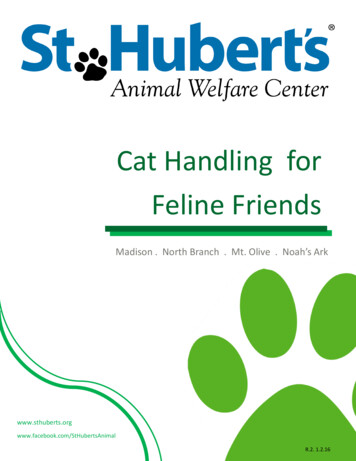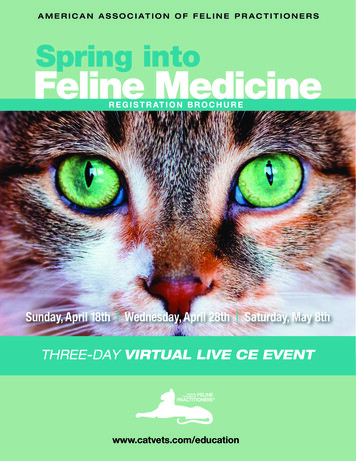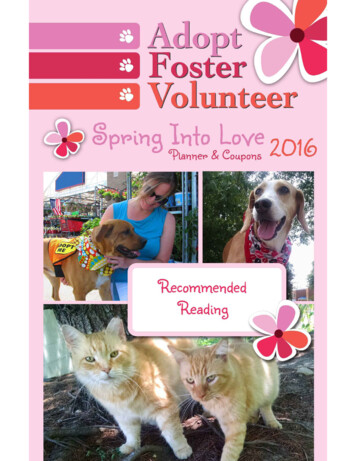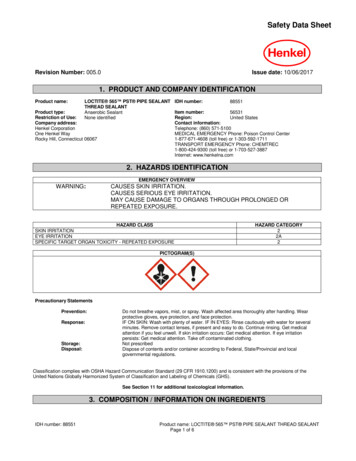
Transcription
Cat Handling forFeline FriendsMadison . North Branch . Mt. Olive . Noah’s alR.2. 1.2.161
TABLE OF CONTENTSIntroduction to Handling 3Cat Body Language . 4,5Cat’s Tail . . . 6A Cat’s Eyes and Ears . . 7,8Cat body posture . 9-11Greeting a new cat 12Worst Cat-Scenario . 13Carrying cats 14Step to a happier shelter cat . 15Purr-sonalities of a cat . 16Barn Buddies and FIV . . 17Recording Cat interaction . 18,19Medical and Behavior alert forms . . 20,21Shy & Sassy cat enrichment . . . . 22Cleaning Procedures . . 23Cattery throughout the day . . 24Staff Only Tasks . . 25Conclusion of the Handling Class . . 262
INTRODUCTION TO CAT HANDLINGVolunteers come to St. Hubert’s with a love for animals. Many feel comfortable with theirhandling skills after housing pets of their own. It is important to remember that animalsin a shelter will not act like the pets in your home. Shelter animals come in to a brandnew environment with no familiar smells, people, or noises. It takes time for cats to adjust to new faces, new smells and the new sounds of a shelter with other cats.It’s important to know the signs of stress and fearful behavior to insure that volunteers remain safe, while the animals are kept as comfortable as possible.BITE PROTOCOL: Animal bites are always a risk while volunteering in a shelter. With caution and proper training most bites are preventable. If a bite or scratch that breaks theskin does occur follow the guidelines below.1) Report the bite immediately to a manager.2) Clean out the wound and seek additional medical care, if necessary.3) Fill out an incident report with staff; include details leading up to the bite. Forms areat the adoption center front desk.The animal must be placed on a 10 day bite holdas required by New Jersey State law.3
CAT BODY LANGUAGECats’ signals are often overlooked, causing bites and scratches that appear to have come outof nowhere. It’s important to notice these subtle signs to insure happy shelter cats and safevolunteers.A HAPPY CAT: Is not always as obvious as a smile Purring *Also self comforting Walks towards you with a raised hind end Tail has a long slow swish Tail carried straight and upward Greets you with a lowered head Scent mark you with its faceA FRIGHTENED CAT: Fear often leads to aggressive behavior due to a feelingof having no other resort Tense or frozen in place Bristled tail, bristle fur on the back Hide in its litter box Crouched body posture Ear flattened back to the headDisplays defensive and aggressiveattributes if frightened cat continues tobe scared, including scratching andbiting. Carries tail low Roll over in last defense, exposing all 4 paws/claws4
CAT BODY LANGUAGECats signals are often overlooked causing bites and scratches that appear to have come outof nowhere. It’s important to notice these subtle signs to insure happy shelter cats and safevolunteers.A lesson fromstop lightkitty.A DEFENSIVE CAT: is warning you to step away Hiss or spit, displaying fangs Arched back, laying or standing Fur along the back on end Sideways stance to appear larger Flatten earsA POTENTIALLY AGGRESSIVE CAT:Often a last resort when all earliersigns have been ignored Hiss or spit, growl Low tail, swishing rapidly Lunge Bite and scratchBefore actively lunging, the cat willappear with similar body language asa defensive cat.5
A CAT’S TAIL HAS SO MUCH TO SAY! Approachable cats have raised non-bristled tails andwelcome your attention. As the tail lowers, the cat is becoming increasinglyuncomfortable most often and it’s best to give the felineits space. The wag of the tail also has meaning which will beobserved in the free roaming room.6
A CAT’S EYES AND EARSHappyAngryPlayfulContentFrightenedHow would you approach the following cats?Image 1Image 2Image 37
ST. HUBERT’S ALUMNIImage 4Image 7Image 5Image 6It’s important to look at the personand the cat’s comfort level8
CAT BODY LANGUAGE /aspca felineality cat body postures 0 0.pdf9
CAT BODY LANGUAGE /aspca felineality cat body postures 0 0.pdf10
CAT BODY LANGUAGE /aspca felineality cat body postures 0 0.pdf11
GREETING A NEW CATWITHIN CAGESCats in a cage need additional consideration and attention because they can not walkaway when they’ve had enough. Your ability to accurately read the cat’s behavior iscrucial to keep it comfortable and you safe.OBSERVE the cat in its cage Let the cat adjust to your voice, smell, presence Open the door to the cage Extend your knuckles for scent marking Take a moment to scratch the cat’s head, and ears.Observe the reaction to continue, or leave while thecat shows the early stages of asking for space.If the cat is against the back of the cage Do not go into the cat’s safe zone Allow the cat the option to approach you in the frontof the cage Do not pick up or try to corner a cat who chooses toremain in the back of their cageWITHIN FREE ROAMING ROOMSWithin the free roaming rooms, cats have the option to be in open or hidden spaces.Cats are able to approach you and request attention. Cats also have the option to shyaway. It’s important to read the body language and be sure that you are socializingwith a cat who is happy to have you here at that moment. Let the cat smell your fist, adjust to your voice, smell, presence Pet the cat who allows, being sure to keep your eyes on the cat you are petting Continue to watch the cat’s body language12
WORST CAT-SCENARIORUN AWAY CAT!First, ALERT STAFF! Cat escapes are possible with doorways that open for staff, volunteers and potential adopters to come in and out. Follow these steps if a cat escapes. Let potential adopters know to remain calm. Fast jerky movements or chasing acat will only chase them further away. Coax the cat to you with treats or a soft noise. If the cat is comfortable and approachable, pick up the cat and return to thecorrect room. If the cat is not easily approachable, notify a staff person. If you are unsure which room the cat came out of, notify a staff person beforeplacing into a room.Remember,Keep calm and carry onCAT FIGHTSWhen a cat fight occurs, never put yourself between the cats. A loud noise will oftenseparate the cats. Try clapping or speaking loudly. When a new cat is being introduced to a community room, there will be a crate that gives the cat an area to retreatto, if it prefers. Be sure there are areas that cats can spend time alone within the freeroaming rooms. If a cat fight does break out, notify staff.13
CARRYING CATSHOW TO HOLD A CATVolunteers have the benefit of only having to handle the cats who wish to be handled.Trained staff will socialize any cat who may not be comfortable with volunteers. Somecats do best with staff who see the cat daily, building trusted relationships.CATS IN CARRIERSCats are placed into carriers to transport the animal throughout the building. Thiscould be to clean cages, provide medical attention, or leave the shelter once adopted!Carriers can be stressful for cats but a quick and safe entrance into the carrier willmake the experience easier. Place the carrier with the opening facing the top Secure the cat with two hands, one below the hind legs, one below the front legs. Gently lower the cat into the carrier Secure the carrier door Gently place the carrier onto its side. Being sure the cat has time to adjust to theflooring.WHAT TO AVOIDNo one is to hold a cat by the scruff of its neck.Never pick a cat up by its legs.14
STEPS TO A HAPPIER SHELTER CATTurn that Frown . Upside down! Provide dark and cozy hide outs. Let me get to know you. Let the cat adjust to your presence. Keep it quiet. Cats have sensitive ears and are startled by sudden loudnoises. I love consistency! Cats thrive on routine; deliver meals on schedule,replace bedding to the same corners. That bed is mine, right? Make sure there are enough comfortable places for all the cats within a room to lie on. All sleep and no play makes a dull day. Provide enrichment and socialization. I need challenges that stimulate my mind! Toys, puzzles, stuffed mice,wand toys are terrific! Catnip for cats over 1 year old.15
PURR-SONALITIES OF CATSJust like people, cats have a range of personalities. It’s important to know a cats purrsonality to both make their time within the shelter more enjoyable and to make a moresuitable adoption match. Here are some broad categories a cat may fall under.BEST FUR-FRIENDS FUR-EVER!Well hello volunteers! Thanks for coming into my room! Don’tmind me while I rub against your leg, act a little vocal, and craveyour attention like I haven’t eaten in days! Don’t let this fool youthough, I was fed this morning by the nice people.AN INDEPENDENT COMPANIONWell hello again, volunteers. I must say I do enjoy you being heretime to time. I may not approach you but I will take in a few petswhen you come my way. Once I’m done, I will let you know.GOTTA GET TO KNOW YOUAh well, I’m not like those other cats. I won’t go spreadingaround my affection to just anyone, only that special someone.Some say it may be why I stay at the shelter longer, but I won’treplace quantity for quality time from the select few. If I warmup to you, this will be a beautiful relationship.16
BARN BUDDIES Barn Buddies are independent cats who likeindoor/outdoor environments like backyards, garages, and barns. These cats donot wish to live out their days on your lapand will not succeed as an indoor house cat. Adopters provide food, water, and access toshelter; the cats provide excellent rodentpopulation control! All Barn Buddies are spayed/neutered andvaccinated.FIV POSITIVE CATSFeline Immunodeficiency virus (FIV) positive cats are positively adoptable!HOW IT’S SPREAD: Spread between cats during reproduction or coming incontact with infected blood, bite wounds.SPECIAL CONSIDERATIONS: While they usually don’t require any special medical care, they typically have a weaker immune system and are more prone tocontracting certain ailments when exposed to them. They should be kept indoors, fed a balanced diet and have routine health exams by a veterinarian.Can FIV cats live with non FIV cats? Yes! If all cats are spayed/neuteredand get along with one another.17
CAT ENRICHMENTCat enrichment is an important part of volunteering. It’s important to keep a cat’s mindstimulated and its need for affection met. To insure all cats receive the enrichmentnecessary a code system is used.OVERLOOKED CAT BOOK COLOR CODEACTION: 30 days in the shelterPICK ME: 60-99 days in the shelter.OVERLOOKED: 100 Days in the shelterThe length of stay does not determine if I’m agood or misbehaved cat, it simply means theright home for me has not been found.18
RECORDING CAT INTERACTIONThe more information recorded about individual cats, the better we are able to placethem in homes. Whether it’s a favorite toy, or a quirky dislike, this information is valuablefor a successful transition into forever homes.CAT-TIVITIESWhat you did with the cat during your volunteer time.Cats name: Mr. FluffyDateInitialsDetails12/21/15JL VOLPetting on lap, treats given, wand toyCAT-TRIBUTESWhat characteristics the cats show that we can pass along to the potential adopterCats name:Mrs. FluffyDateInitialsDetails12/21/15JL VOLMrs. Fluffy did not like being picked up. Enjoyedbeing pet instead!19
SHY AND SASSY CAT ENRICHMENTOverlooked cats may have a longer length of stay due to shy or sassy behavior. Meaningful volunteer interactions with these animals can better their lives and improve theirchances for a timely adoption.SUCCESS WITH A SHY CAT Offer a calm and predictable setting. These cats need time tobuild connections and enjoy interactions with calm people. Don’t force interaction; extend a closed fist to allow for sniffing.If the cat is interested it will approach. Stop if the cat becomes stressed. Keep your interactions short, yet frequent. Staying with a shycat for too long may cause added stress.SUCCESS WITH A SASSY CAT Sassy cats can make for great play dates. It’s important to use toys for play,avoiding drawing the cat’s attention to your hands. Sassy cats may bite, scratch,bite, and pounce. Keep all sassy cats playing with toys and wands. Only pet if the cat solicits your attention.20
CLEANING PROCEDURESIt is important to follow the staff member’s lead on how cleaning is conducted at your location. Below are some general truths about cat cleanings at St. Hubert’s.SPOT CLEANING:Cats thrive with routine andconsistency. Moving a cat’s bed can increase stress letalone moving everything daily for cleanings. Spot cleaning lowers periods of stress in shelter cats while keepingthings sanitary. Litterscoops do not go into the sink atthe same time bowls are being washed.BE OBSERVANT: While you are cleaning, look atthe cats, their litterboxes and their cages for signs of illness. Note if any cats are sneezing, or have diarrhea andtell the medical tech by using the medical alert form.FEEDINGS: With guidance from staff, prepare foodand feed cats. Every cat/kitten gets 1 tablespoon of wet food. Check cage cards for ‘no wetfood’ signs before feeding. Kittens and thin cats receive asecond feeding at 2PM. Some cats are on special diets, i.e.,grain-free etc.DEEP CLEAN, SCRUB DAY: On certain days staffmay ask you to assist with additional roles to help clean.Cats will be removed from the rooms and cages so all wallsand windows may be scrubbed down as well. Follow thestaff member’s guidance on what your role is onthese days. Unplug water fountains and anyother electronics.21
CATTERY THROUGHOUT THE DAYFeline friend volunteers begin socializing cats at Noonwhen morning cleanings have been completed. If youwould like to volunteer before 12:00PM sign up forKennel Attendant—Cattery.MORNINGSVolunteers arrive at 8:30AM for morning cleanings.In the mornings, all bedding is pulled, fresh water given andthe morning feeding follows.AFTERNOONS 2PM, feed all kittens and any thin, sick or old cats their secondfeeding of canned food. Check all cages to see if they need water. If cats spilled their water, replace bedding and paper asneeded.EVENINGS Check all cages to see if they need more water. If cage is dirty, spot clean as necessary. Give cats/kittens additional enrichment items - cottonballs with Feliway,kitty kongs, etc. Unplug water fountains and radio.22
STAFF-ONLY TASKSOn occasion you may see a fellow volunteer contributing in astaff-only role. These volunteers have shown greatcommitment and have undergone additional training. Pleaseremember that the following roles are staff only. Cat meet and greets with a potential adopterInteracting with cats who are owned and within the lobby awaiting intakeInteracting with cats who are in ring worm, URI, or ISOlabeled rooms.Interacting with any cats who show signs of aggressionor fear.23
CONCLUSION AND NEXT STEPCongratulations! You have completed the classroom portionof the cat handling course.1) Take the next 15 minutes to try out reading the behaviorof cats in the cattery.2) Receive your cat handling nametag3) Sign up for Feline Friend Volunteer shifts4) Begin volunteering to socialize the cats of St. Hubert’s!MEEOOWWW!I would like to thankthe A-CAT-demy.Thank you to the staff and volunteers whocontributed through being in or by takingphotos for this handbook. A special thanks toMark Lovretin for his photography.24
Do not go into the cat [s safe zone Allow the cat the option to approach you in the front of the cage Do not pick up or try to corner a cat who chooses to remain in the back of their cage Within the free roaming rooms, cats have the option to be in open or hidden sp










